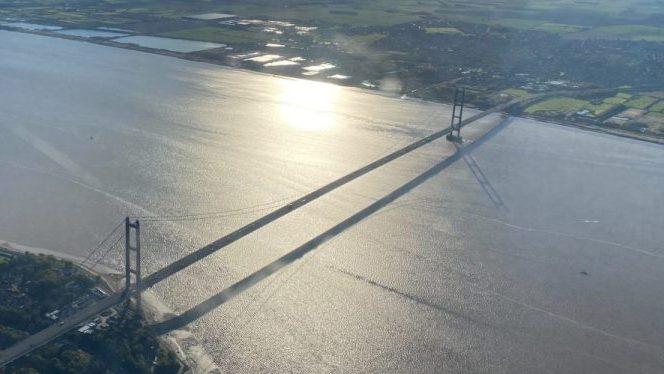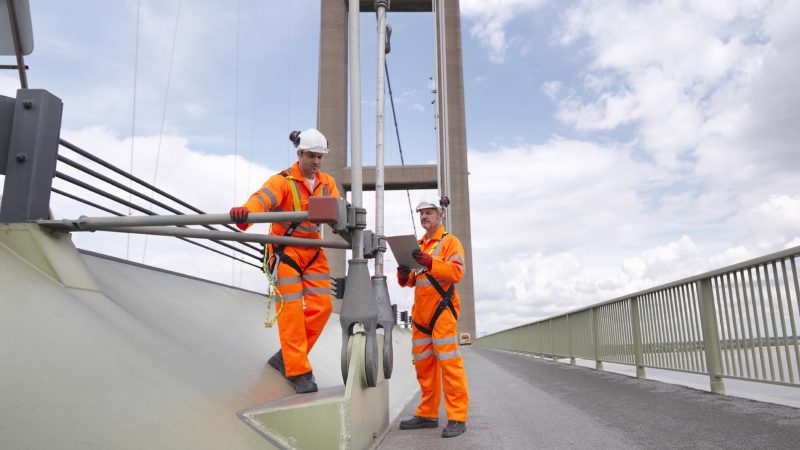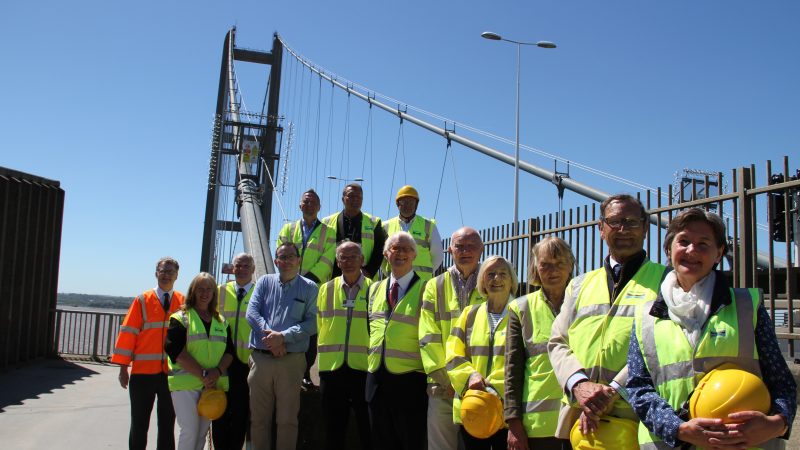THE HUMBER BRIDGE IS AN ICONIC LANDMARK FOR THE REGION. A FEAT OF MODERN BRITISH ENGINEERING. A GRADE 1 LISTED STRUCTURE. A WELCOME SIGN OF HOME AFTER A LONG TRIP.
Officially opened by Her Majesty Queen Elizabeth II on 17th July 1981 (though Our History goes back much further), the Bridge represents a long-held desire to connect the Humber region. Prior to the Bridge, the only way of crossing the Humber was either by ferry, or a drive around between 55.3 and 80 miles!
Bridges and tunnels had been considered, but it wasn’t until 1959 that a viable crossing became a reality with the granting of the 1959 Humber Bridge Act. Although work did not start until 1972.
It took 8 years to build the Humber Bridge during which time workers endured some of the UK’s worst weather conditions. At times over 1,000 people worked on the Bridge at once!
Today the Humber Bridge provides a vital role in helping the region to reach its full potential; supporting 33,000 crossings per day and saving drivers millions of miles and hours overall.
THE HUMBER BRIDGE BOARD
The Humber Bridge Board is a statutory board that ensures the running and maintenance of the Bridge and approach roads through the collection of tolls. It employs around 100 staff, who are based at the Humber Bridge.
THE BOARD OF DIRECTORS
The Board of the Humber Bridge comprises representatives of all four local unitary authorities serving Hull, East Riding of Yorkshire, North Lincolnshire and North East Lincolnshire, plus two people nominated by the Hull and East Yorkshire LEP and Greater Lincolnshire LEP (Local Enterprise Partnership). The Board meets every two months.
SEE HERE FOR MORE INFORMATION
KEY PEOPLE
Chief Operating Officer: Andrew Arundel
Deputy Chief Operating Officer: Fay Baker
STATS
-On average there are 33,000 crossings per day.
– As of 2024, more than a 1/4 of a billion vehicles have crossed since 1981.
-Between April 2023 and May 2024 an estimated 220,677 pedestrians and 78,104 cyclists used the walkway.
-Around 44 miles are saved per journey between Hull and Grimsby.
SOCIAL VALUE

Between April 2023 and March 2024, the Humber Bridge and its surrounding estate generated £3.42 in social and economic value for every £1 invested by the Humber Bridge Board.
According to our latest report from the Social Value Engine, the bridge produces £2.4 million annually in social value.
The Social Value Engine is used by governments, councils, public bodies, and private companies across the UK to assess the true impact and importance of projects.
It uses the internationally recognised United Nations Sustainable Development Goals as its framework, outlining the 17 characteristics of a sustainable global community.
This includes things such as volunteering and community activities, improved well-being through cultural and sports events, training for job skills, access to natural resources, a reduced carbon footprint, and the social impact of local spending and using low-emission vehicles.
The Humber Bridge holds a special place in the lives of those in the region, enabling people to live and work on both sides of the estuary. It’s used by commuters, visitors, cyclists, runners, tourists, and people taking part in charity events in equal measure. We love how much the bridge means to so many people and it’s great to be able to quantify this.
To find out more, please visit: https://socialvalueengine.com
FAST BRIDGE FACTS
-The Bridge crosses the Humber Estuary between Hessle, East Yorkshire and Barton upon Humber, North Lincolnshire.
-Between 1981 and 1998, it was the world’s longest single-span suspension bridge. It is currently the twelfth longest.
-But the Humber Bridge is the UK’s longest single-span suspension bridge.
-The Humber Bridge is one of the longest single span suspension bridges in the world which allows cyclists and pedestrians.
-The road deck has an aerodynamic design, like an upside-down aircraft wing. This keeps the deck stable during high winds.
–124 steel box sections weighing over 17,000 tonnes make up the road deck.
-The road deck is 30m above high water level to enable the passage of ships beneath.
-The concrete towers are 155.5 metres (510 feet) tall and were built to be 36mm further apart from each other at the top than at the bottom, to allow for the curvature of the Earth.
-Anchorage to anchorage the Bridge is 2,200 metres or around 1.4 miles.
-The 3 spans are; Hessle side span (280 metres), Barton side span (530 metres) and the main centre span (1410 metres).
-There is enough wire used in the bridge to go around the Moon more than six times.
FREQUENTLY ASKED QUESTIONS
The Humber Bridge Board is a statutory body created by the Humber Bridge Act 1959 and subsequent legislation. Meet the Board.
The Bridge is open 24/7, 365 days of the year. There are occasions when it is impassable for ‘high-sided and wind vulnerable’ vehicles due to high winds.
The Humber Bridge has two birthdays! It was first opened to traffic on 24th June 1981; but the formal opening by the Her Majesty Queen Elizabeth II was on 17th July 1981.
Yes – The Humber Bridge has a publicly accessible footpath for pedestrians and cyclists to use, allowing visitors to enjoy the views of both the Humber as they cross the estuary.
On the north bank of the estuary is East Yorkshire, chiefly the regions of Hessle and Hull. The south bank is North Lincolnshire and North East Lincolnshire, with the towns of Barton and Grimsby located near the bridge.
Follow the links to the official websites for these areas to learn more about them, what there is to see and do, and where to stay.



